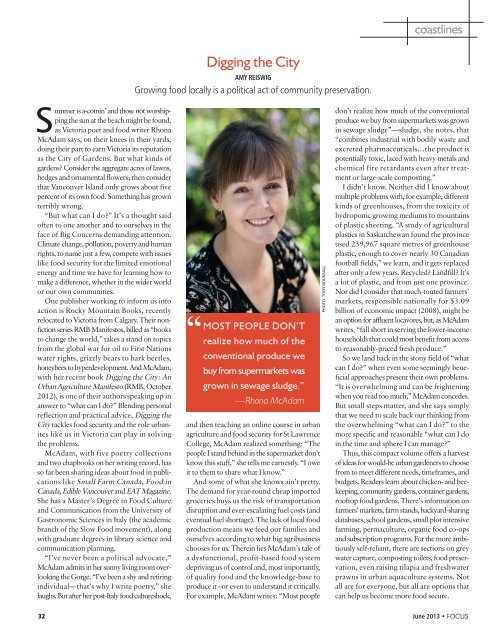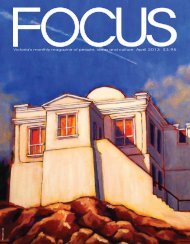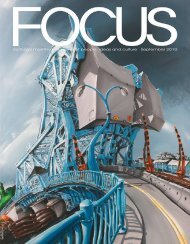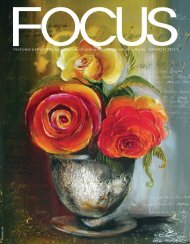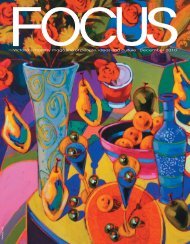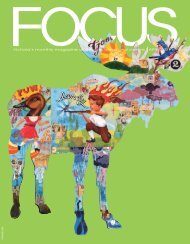***Mar 2006 Focus pg 1-32 - Focus Magazine
***Mar 2006 Focus pg 1-32 - Focus Magazine
***Mar 2006 Focus pg 1-32 - Focus Magazine
You also want an ePaper? Increase the reach of your titles
YUMPU automatically turns print PDFs into web optimized ePapers that Google loves.
coastlinesDigging the CityAMY REISWIGGrowing food locally is a political act of community preservation.Summer is a-comin’ and those not worshippingthe sun at the beach might be found,as Victoria poet and food writer RhonaMcAdam says, on their knees in their yards,doing their part to earn Victoria its reputationas the City of Gardens. But what kinds ofgardens? Consider the aggregate acres of lawns,hedges and ornamental flowers; then considerthat Vancouver Island only grows about fivepercent of its own food. Something has grownterribly wrong.“But what can I do?” It’s a thought saidoften to one another and to ourselves in theface of Big Concerns demanding attention.Climate change, pollution, poverty and humanrights, to name just a few, compete with issueslike food security for the limited emotionalenergy and time we have for learning how tomake a difference, whether in the wider worldor our own communities.One publisher working to inform us intoaction is Rocky Mountain Books, recentlyrelocated to Victoria from Calgary. Their nonfictionseries RMB Manifestos, billed as “booksto change the world,” takes a stand on topicsfrom the global war for oil to First Nationswater rights, grizzly bears to bark beetles,honeybees to hyperdevelopment. And McAdam,with her recent book Digging the City: AnUrban Agriculture Manifesto (RMB, October2012), is one of their authors speaking up inanswer to “what can I do?” Blending personalreflection and practical advice, Digging theCity tackles food security and the role urbaniteslike us in Victoria can play in solvingthe problems.McAdam, with five poetry collectionsand two chapbooks on her writing record, hasso far been sharing ideas about food in publicationslike Small Farm Canada, Food inCanada, Edible Vancouver and EAT <strong>Magazine</strong>.She has a Master’s Degree in Food Cultureand Communication from the University ofGastronomic Sciences in Italy (the academicbranch of the Slow Food movement), alongwith graduate degrees in library science andcommunication planning.“I’ve never been a political advocate,”McAdam admits in her sunny living room overlookingthe Gorge. “I’ve been a shy and retiringindividual—that’s why I write poetry,” shelaughs. But after her post-Italy food cultureshock,“MOST PEOPLE DON’Trealize how much of theconventional produce webuy from supermarkets wasgrown in sewage sludge.”—Rhona McAdamand then teaching an online course in urbanagriculture and food security for St LawrenceCollege, McAdam realized something: “Thepeople I stand behind in the supermarket don’tknow this stuff,” she tells me earnestly. “I oweit to them to share what I know.”And some of what she knows ain’t pretty.The demand for year-round cheap importedgroceries buys us the risk of transportationdisruption and ever-escalating fuel costs (andeventual fuel shortage). The lack of local foodproduction means we feed our families andourselves according to what big agribusinesschooses for us. Therein lies McAdam’s tale ofa dysfunctional, profit-based food systemdepriving us of control and, most importantly,of quality food and the knowledge-base toproduce it –or even to understand it critically.For example, McAdam writes: “Most peoplePHOTO: TONY BOUNSALLdon’t realize how much of the conventionalproduce we buy from supermarkets was grownin sewage sludge”—sludge, she notes, that“combines industrial with bodily waste andexcreted pharmaceuticals…the product ispotentially toxic, laced with heavy metals andchemical fire retardants even after treatmentor large-scale composting.”I didn’t know. Neither did I know aboutmultiple problems with, for example, differentkinds of greenhouses, from the toxicity ofhydroponic growing mediums to mountainsof plastic sheeting. “A study of agriculturalplastics in Saskatchewan found the provinceused 239,967 square metres of greenhouseplastic, enough to cover nearly 30 Canadianfootball fields,” we learn, and it gets replacedafter only a few years. Recycled? Landfill? It’sa lot of plastic, and from just one province.Nor did I consider that much-touted farmers’markets, responsible nationally for $3.09billion of economic impact (2008), might bean option for affluent locavores, but, as McAdamwrites, “fall short in serving the lower-incomehouseholds that could most benefit from accessto reasonably-priced fresh produce.”So we land back in the stony field of “whatcan I do?” when even some seemingly beneficialapproaches present their own problems.“It is overwhelming and can be frighteningwhen you read too much,” McAdam concedes.But small steps matter, and she says simplythat we need to scale back our thinking fromthe overwhelming “what can I do?” to themore specific and reasonable “what can I doin the time and sphere I can manage?”Thus, this compact volume offers a harvestof ideas for would-be urban gardeners to choosefrom to meet different needs, timeframes, andbudgets. Readers learn about chicken- and beekeeping,community gardens, container gardens,rooftop food gardens. There’s information onfarmers’ markets, farm stands, backyard-sharingdatabases, school gardens, small plot intensivefarming, permaculture, organic food co-opsand subscription programs. For the more ambitiouslyself-reliant, there are sections on greywater capture, composting toilets, food preservation,even raising tilapia and freshwaterprawns in urban aquaculture systems. Notall are for everyone, but all are options thatcan help us become more food secure.<strong>32</strong> June 2013 • FOCUS


